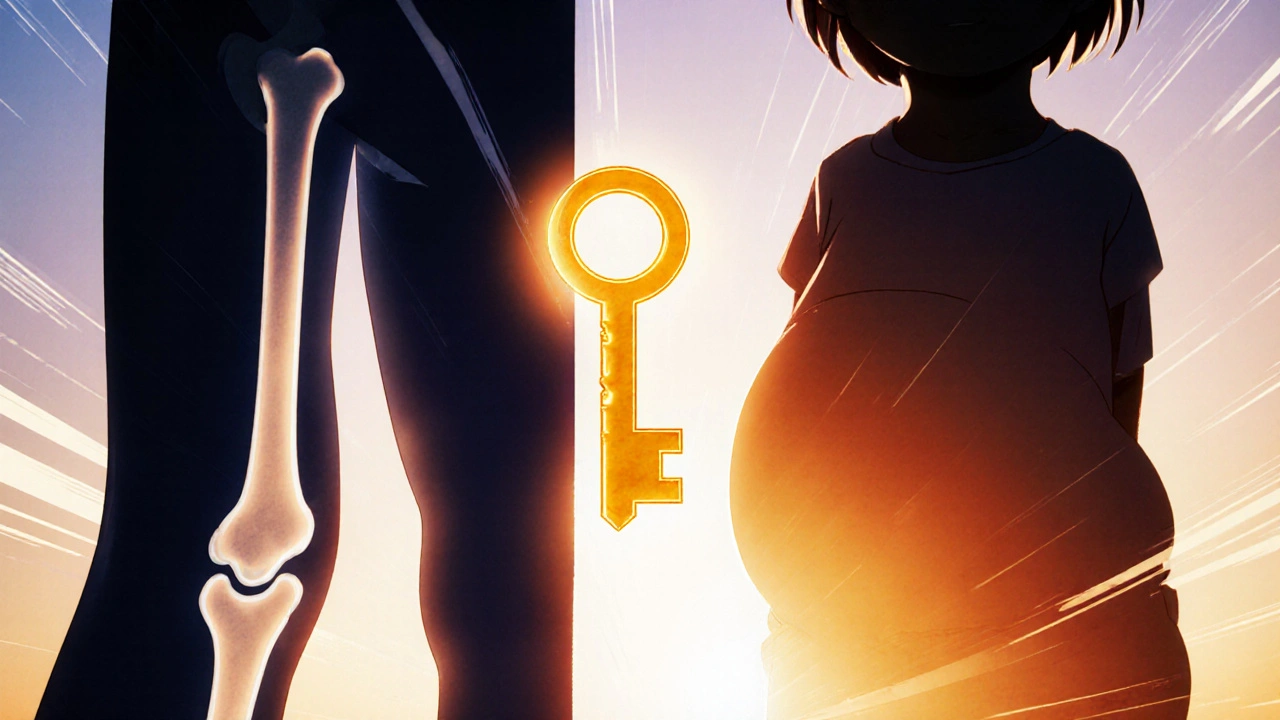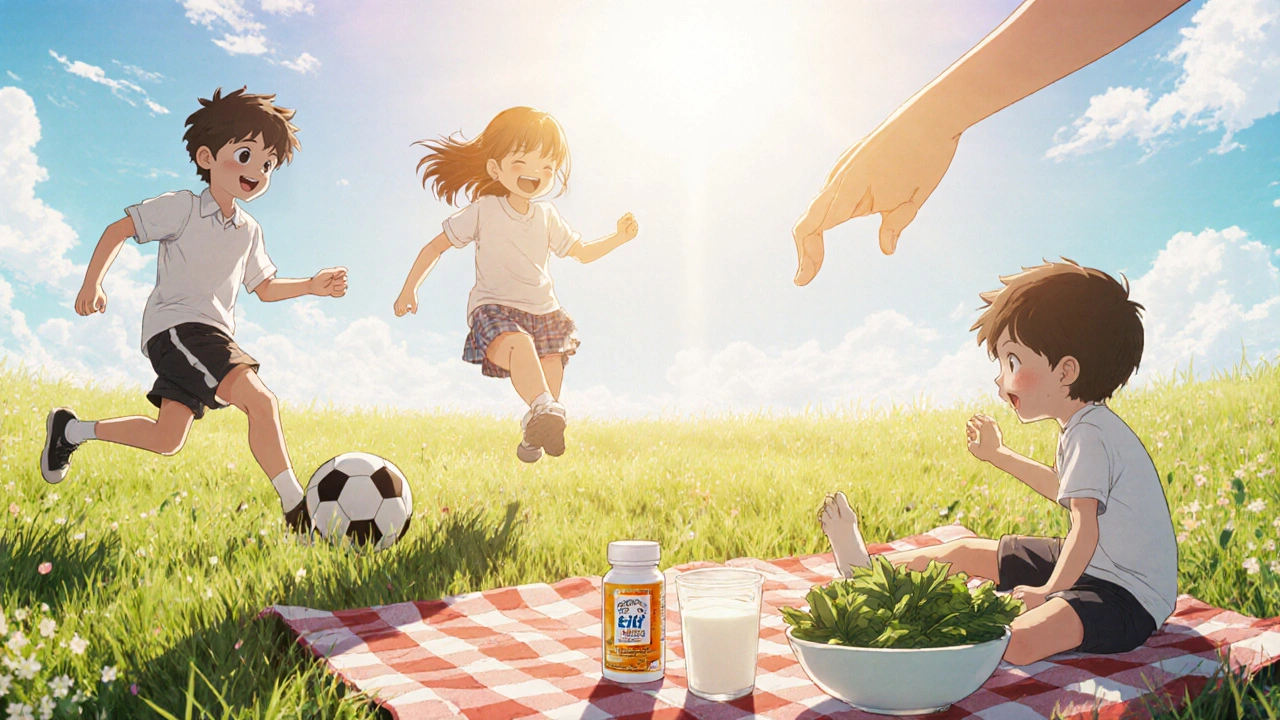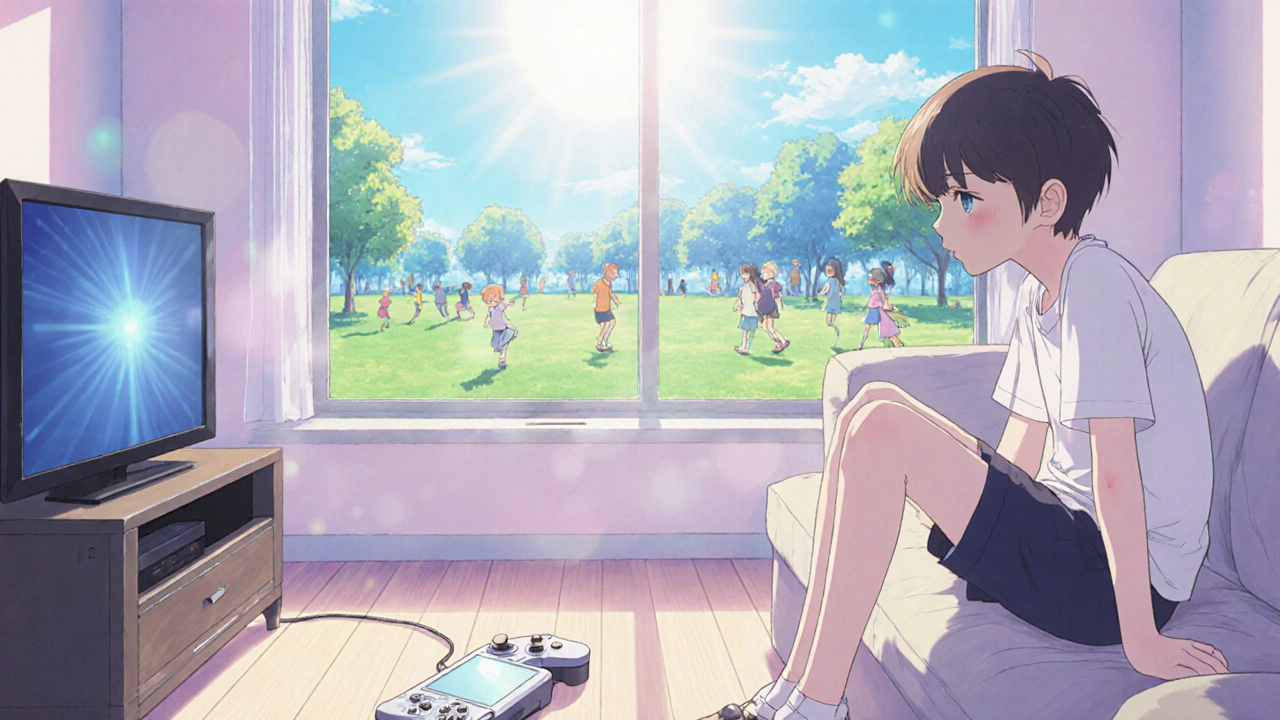Rickets and Obesity Risk Assessment Tool
This tool assesses your child's risk of both rickets and obesity based on key factors discussed in the article. Enter information about your child's diet, activity levels, and vitamin D exposure to see their risk levels and get personalized recommendations.
Risk Assessment Form
Quick Takeaways
- Rickets and obesity share common nutritional and lifestyle drivers, especially low vitamin D and excess calorie intake.
- Children with high body mass index (BMI) are more likely to show signs of poor bone mineralisation.
- Vitamin D influences both calcium absorption for bone health and insulin sensitivity, linking the two conditions.
- Screen‑time, sedentary habits, and inadequate sunlight exposure fuel the dual problem.
- Addressing diet, outdoor activity, and targeted supplementation can break the cycle.
What Is Rickets?
When you hear the word Rickets is a childhood bone disorder caused by insufficient mineralisation of the growth plates, the image that often comes to mind is bowed legs or a soft skull. The condition stems from a shortfall of calcium or phosphate, most commonly because the body can’t absorb enough vitamin D. Vitamin D acts like a key that unlocks calcium from the gut and shuttles it into the bloodstream where it can be deposited in bone. Without enough of this key, the growing skeleton stays soft, leading to pain, deformities, and in severe cases, fractures.
Understanding Obesity
On the flip side, Obesity is a medical condition defined by excess body fat that impairs health. In children, doctors use the Body Mass Index (BMI) percentile to gauge where a child stands compared to peers. A BMI at or above the 95th percentile marks obesity. This excess weight isn’t just a cosmetic issue; it raises the risk of type‑2 diabetes, hypertension, and early heart disease.

How Vitamin D Bridges the Gap
Vitamin D isn’t only about calcium. It also plays a pivotal role in the endocrine system. Research shows that low vitamin D levels correlate with higher Insulin Resistance, a hallmark of obesity‑related metabolic disturbance. When insulin resistance spikes, the body stores more fat and burns less, creating a feedback loop that can aggravate both obesity and bone weakness.
In 2023, a meta‑analysis of 27 studies involving over 13,000 children found that those with vitamin D concentrations below 20 ng/mL were 1.8 times more likely to be classified as obese and 2.2 times more likely to display radiographic signs of rickets. The dual impact underscores why clinicians now screen for vitamin D when confronting either condition.
Shared Lifestyle Factors
Below is a snapshot of overlapping risk factors that push kids toward both rickets and obesity:
| Risk Factor | Impact on Rickets | Impact on Obesity |
|---|---|---|
| Inadequate Sunlight Exposure | Reduces skin‑synthesized vitamin D → poor calcium absorption | Limits vitamin D‑mediated insulin sensitivity → fat accumulation |
| High‑calorie, low‑nutrient diet | Low calcium & vitamin D intake | Excess calories promote weight gain |
| Sedentary lifestyle (screen time) | Less outdoor play → less sun | Lower energy expenditure → weight gain |
| Genetic predisposition | Variants in vitamin D receptor (VDR) genes affect bone health | Genes influencing appetite and fat storage |
Clinical Evidence of a Direct Link
Beyond population studies, clinical observations support a causal relationship. Pediatric endocrinology units in Adelaide reported a rise in co‑occurring cases after the COVID‑19 lockdowns, attributing the spike to diminished outdoor time. Children who presented with rickets also displayed elevated fasting insulin levels, a red flag for emerging metabolic syndrome.
Intervention trials provide hopeful data. One 2022 randomized trial gave 400 IU /day of Vitamin D supplementation to obese children with borderline rickets for six months. Results showed a 30 % reduction in BMI percentile and a 45 % improvement in tibial mineral density scores. The dual benefit suggests that correcting vitamin D deficiency can simultaneously curb weight gain and strengthen bones.

Practical Steps for Parents and Caregivers
- Check vitamin D levels. Ask your pediatrician for a serum 25‑hydroxyvitamin D test, especially if your child spends most time indoors.
- Boost safe sun exposure. Aim for 10‑15 minutes of midday sunlight on uncovered arms and legs, 3‑4 times per week, while respecting skin‑type guidelines.
- Prioritise calcium‑rich foods. Dairy, fortified plant milks, leafy greens, and sardines deliver the calcium needed for bone mineralisation.
- Include vitamin D‑fortified products. Look for milk, orange juice, and cereals that list vitamin D (at least 400 IU per serving).
- Limit sugary drinks and processed snacks. These contribute empty calories that fuel obesity and displace nutrient‑dense options.
- Encourage regular physical activity. Sports, bike rides, or simply playing in the park improve insulin sensitivity and stimulate bone growth.
- Consider targeted supplementation. If dietary changes fall short, a pediatric‑approved dose of Vitamin D (typically 600‑1000 IU daily) and calcium (500‑1000 mg) can fill gaps.
- Monitor growth charts. Keeping an eye on height, weight, and BMI percentile helps catch early signs of either condition.
Remember, the goal isn’t a quick fix but a sustainable lifestyle that supports both a strong skeleton and a healthy weight.
Frequently Asked Questions
Can a child be overweight without having rickets?
Yes. Overweight status alone does not guarantee a vitamin D or calcium deficiency. However, many overweight children do have low vitamin D, which can increase rickets risk if calcium intake is also low.
Is sunlight the best source of vitamin D for kids?
Sunlight is the most natural source because UV‑B rays convert a skin cholesterol precursor into vitamin D. For children with limited sun exposure, fortified foods or supplements become essential.
How much vitamin D should a child take daily?
The Australian Dietary Guidelines recommend 600 IU per day for children aged 1-18. Doctors may prescribe higher doses (up to 1000 IU) for deficiency correction under supervision.
Can obesity mask the symptoms of rickets?
Yes. When excess fat covers the bones, classic signs like bowed legs can be less obvious, delaying diagnosis until a fracture or severe pain occurs.
What role does calcium play in this relationship?
Calcium is the building block of bone tissue. Without adequate vitamin D, calcium absorption drops, worsening rickets. Calcium alone won’t fix obesity, but a diet rich in calcium can support weight management by promoting satiety.
Bottom Line
While rickets and obesity may seem like separate health woes, they often stem from the same nutrition gaps and sedentary habits. By tackling vitamin D deficiency, boosting calcium intake, and encouraging active outdoor play, families can protect their kids’ bones and keep excess weight at bay. Early screening and a balanced approach are the most effective way to break the cycle.


From a mechanistic standpoint, the etiopathogenesis of pediatric rickets and obesity converges upon perturbations in the vitamin D endocrine axis, which modulates both calcium homeostasis and insulin signalling pathways. Dysregulated 25-hydroxyvitamin D synthesis attenuates intestinal calcium absorption, thereby compromising hydroxyapatite crystal formation within the growth plate. Concurrently, suboptimal vitamin D status diminishes insulin receptor sensitivity, fostering adipogenic transcriptional programs and ectopic lipid deposition. Epidemiological meta-analyses have quantified a nearly twofold increase in combined prevalence of low serum 25(OH)D and elevated body mass index percentiles among children under fifteen. Moreover, genome-wide association studies implicate polymorphisms in the VDR and FTO loci as synergistic risk enhancers for both phenotypes. The temporal association observed in post‑lockdown cohorts underscores the role of environmental modifiers, particularly reduced ultraviolet B exposure and heightened sedentary behaviours. Clinical trials administering 400 IU of vitamin D daily have demonstrated not only improvements in tibial mineral density but also modest reductions in BMI z‑scores, suggesting a bidirectional therapeutic window. It is imperative that pediatric practitioners adopt a dual‑screening protocol, incorporating serum 25‑hydroxyvitamin D assays alongside routine anthropometric assessments. Preventive strategies should integrate nutritionally dense, calcium‑fortified foods with structured outdoor physical activity regimens. Finally, longitudinal monitoring of growth trajectories will enable early detection of subclinical deficiencies before irreversible skeletal deformities ensue.
Totally agree with the need for balanced screening – a quick blood test can catch a lot before it becomes a bigger issue. Also, encouraging kids to play outside even for short bursts can boost vitamin D and burn some extra calories 😊. Pairing that with calcium‑rich snacks makes the whole plan feel more doable for families.
Oh great, another "vitamin D miracle" article, because that solved everything.
Honestly, the real reason kids get rickets is that the gov'n't doesn't want us outside, they pump chemicals in the air and keep us locked indoors.
I think the article is over-simplifed and miss some real case studys, especially when it comes to low income famlies that cant afford supplements.
Great info! 🌞✨ Let's keep our kids thriving with sunshine, tasty calcium snacks, and fun outdoor games. You’ve got this!
Totally feel you – my niece was battling both issues last summer and we just started a daily walk after dinner, plus some fortified milk. It’s crazy how quickly things can turn around when you mix fun with nutrition. btw, don’t forget to check the label for added sugars!
For clinicians, incorporating a routine serum 25‑hydroxyvitamin D measurement, alongside BMI percentile tracking, provides a comprehensive risk profile; therefore, early detection is possible; moreover, dietary counseling should emphasize calcium‑rich sources-dairy, fortified plant milks, leafy greens-while limiting sugary beverages, which contribute to adiposity without nutrient benefit. Physical activity prescriptions, even at low intensity, improve insulin sensitivity and stimulate osteoblastic activity; consequently, a multidisciplinary approach yields the best outcomes.
While the data is compelling, one must not overlook the profound societal implications of neglecting pediatric bone health; the erosion of our collective future, both literally and figuratively, demands an unwavering moral crusade. Let us, as guardians of the next generation, champion rigorous supplementation protocols and relentless advocacy for outdoor play, lest we succumb to a legacy of weakened spines and insidious obesity.